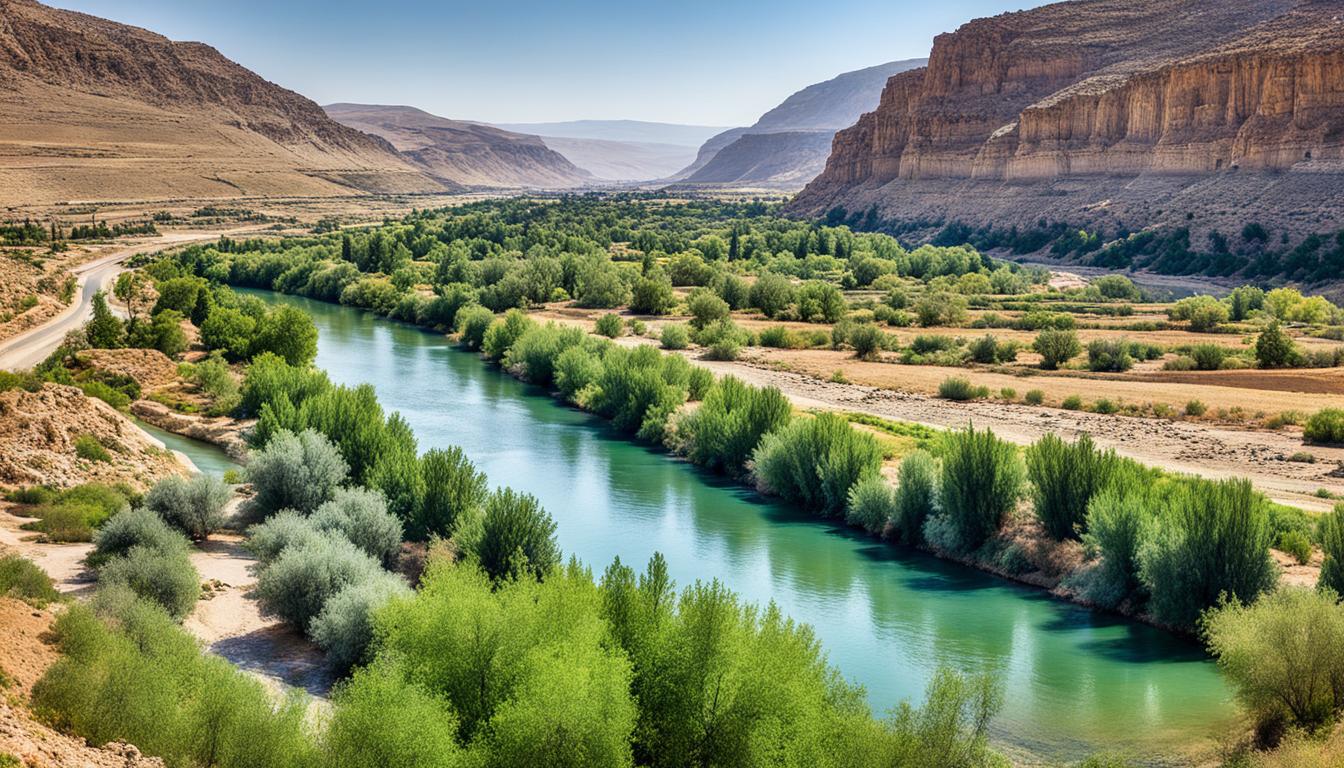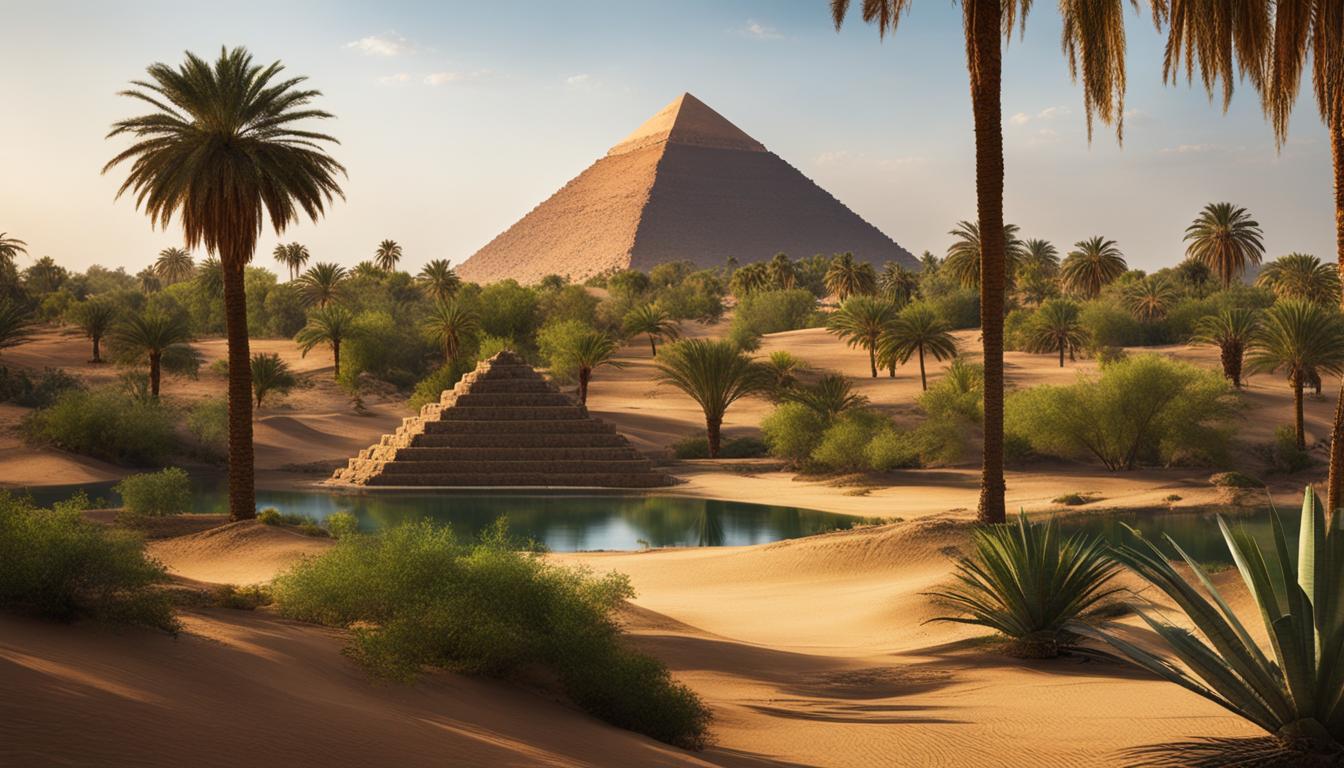The Bible is a book that holds great significance for millions of people worldwide, particularly those who practice Judaism, Christianity, and Islam. Throughout its pages, there are numerous mentions of historical places that are considered holy and have deep religious and historical importance. This article will explore ten such locations, providing insights into their significance and the events associated with them.
Key Takeaways:
- Discover ancient biblical sites with historical and religious significance.
- Explore holy land destinations mentioned in the Bible.
- Learn about the significance of biblical landmarks and sacred places.
- Uncover the events and figures associated with famous biblical sites.
- Experience pilgrimage sites in the Holy Land and connect with your faith.
Tel Megiddo
Tel Megiddo, also known as Armageddon, is an ancient city located in Israel. It holds great significance as a biblical site, mentioned in the Book of Revelation as the location of the end-times battle.
Archaeologists have uncovered 26 layers of human occupation at Tel Megiddo, making it a fascinating site for historical study. It was an important city in the Canaanite and Kingdom of Israel periods.
Tel Megiddo plays a significant role in biblical history, particularly in the Book of Revelation. It is referenced as the site of Armageddon, the epic final battle between good and evil. The city’s strategic location overlooking the Jezreel Valley also contributed to its importance throughout ancient history.
The archaeological discoveries at Tel Megiddo offer valuable insights into the ancient world and shed light on the cultural, political, and religious dynamics of the time. It is a significant destination for those interested in biblical sites and the history of the region.
The Significance of Tel Megiddo
Tel Megiddo’s historical and biblical significance cannot be overstated. Here are a few key points:
- Tel Megiddo is mentioned several times in the Old Testament, serving as an important strategic and trade hub.
- It was a prosperous city during the time of the Canaanites and later served as an administrative center during the Kingdom of Israel.
- The city’s rich archaeological remains provide evidence of ancient warfare and city planning.
- Tel Megiddo’s connection to the Book of Revelation has sparked fascination and speculation about its role in the end-times.
“And they gathered them together to the place called in Hebrew, Armageddon.” – Revelation 16:16
Qumran
Qumran, located in Israel’s West Bank, gained fame in the 1940s when the Dead Sea Scrolls were discovered nearby. These scrolls contain biblical texts and other ancient writings. Qumran is believed to have been an ancient settlement inhabited by the Essenes, a Jewish sect associated with the authorship of the Dead Sea Scrolls. The ruins of buildings and an extensive aqueduct system have been found at the site.
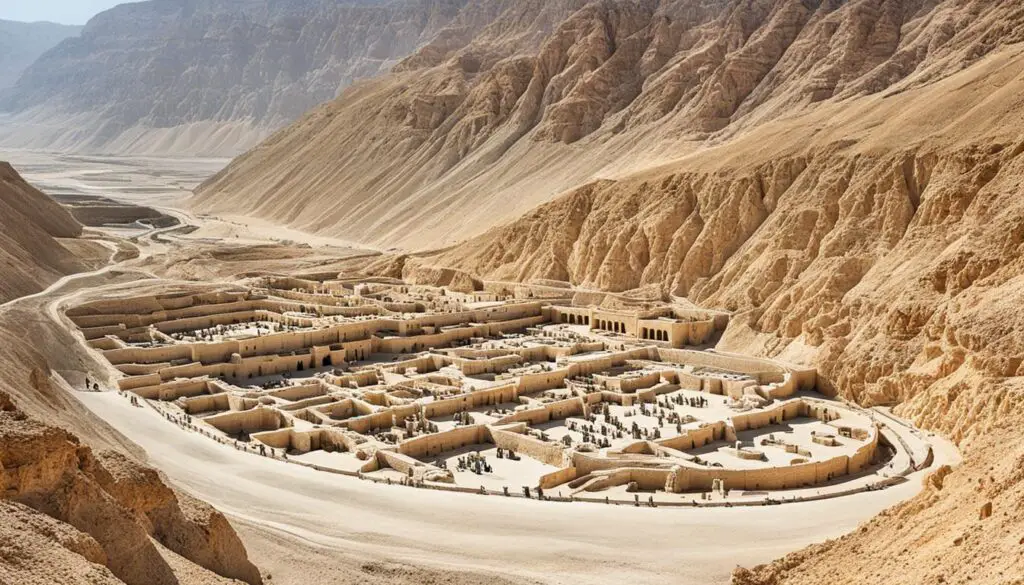
Key Discoveries at Qumran
The excavations at Qumran have provided valuable insights into the ancient settlement and the Essenes who lived there. Some of the key discoveries include:
- The Dead Sea Scrolls: The most significant finding at Qumran, the Dead Sea Scrolls consist of biblical and non-biblical texts, shedding light on religious practices, ancient customs, and historical events from the time of the Second Temple.
- Aqueduct System: Extensive remains of an aqueduct system have been unearthed at Qumran, indicating the advanced water management techniques employed by the Essenes.
- Scriptorium: A room believed to have been a scriptorium was discovered, suggesting that the Essenes were involved in the production and copying of scrolls.
- Residential Complex: The ruins of a residential complex at Qumran provide insights into the communal lifestyle of the Essenes, believed to have been celibate and devoted to religious practices.
“The discovery of the Dead Sea Scrolls at Qumran was a remarkable find that revolutionized Biblical studies. These ancient texts continue to captivate scholars and provide invaluable insights into the religious and historical context of the time.”
– Dr. Sarah Cohen, Archaeologist
Qumran Timeline
| Timeline | Events |
|---|---|
| 2nd century BCE | Establishment of Qumran as a settlement. |
| 1st century BCE | Peak period of Essene activity at Qumran. |
| 66-70 CE | Destruction of Qumran by Roman forces. |
| 1947-1956 | Discovery of the Dead Sea Scrolls in the nearby caves. |
| Excavations | Ongoing excavations at Qumran, uncovering new insights into the ancient settlement and the Essenes. |
Tel Hazor
Tel Hazor is an ancient site located in Israel’s Galilee region. This significant biblical site is believed to have been the site of a major victory for Joshua during the Israelite conquest of Canaan. According to the Old Testament, Joshua and his army defeated the Canaanite king and captured the city of Hazor. The conquest of Hazor played a crucial role in establishing the Israelites’ presence in the Promised Land.
Excavations at Tel Hazor have provided valuable insights into this biblical battle and the ancient city’s strategic importance. Archaeologists have discovered evidence of burned materials and structures, potentially linked to the biblical conflict. Ongoing excavations at the site continue to uncover new artifacts and shed light on the historical events that took place at Tel Hazor.
“Tel Hazor is one of the most important biblical sites in Israel, showcasing the Israelites’ conquest of Canaan and the establishment of their presence in the Holy Land.”
Tel Hazor’s history dates back thousands of years, with settlement at the site dating back to the Bronze Age. The strategic location of Tel Hazor made it a prominent city throughout various periods, including the Canaanite period and the time of the Kingdom of Israel. The remains of the city’s ancient fortifications, palaces, and temples offer a glimpse into the civilization that once thrived here.
While the biblical account of the conquest of Hazor provides a foundation for the site’s historical significance, it is essential to note that there is ongoing debate among archaeologists about the accuracy of certain events described in the Old Testament. Despite the debates, Tel Hazor remains a fascinating site for both biblical and archaeological scholars, offering valuable insights into the ancient history of the region and the ongoing excavations.

Tel Hazor’s ongoing excavations and the discoveries found within its ancient ruins continue to deepen our understanding of the biblical battles and the ancient civilizations that existed in the region. This archaeological site serves as a testament to the rich history of the Holy Land and provides a tangible connection to the events described in the Bible.
Machaerus
Machaerus is an ancient fortress located in Jordan. Situated on a hilltop overlooking the Dead Sea, this formidable structure stands as a testament to the region’s rich history. Built by Herod the Great, the fortified complex served as a military base and a symbol of Herod’s power.
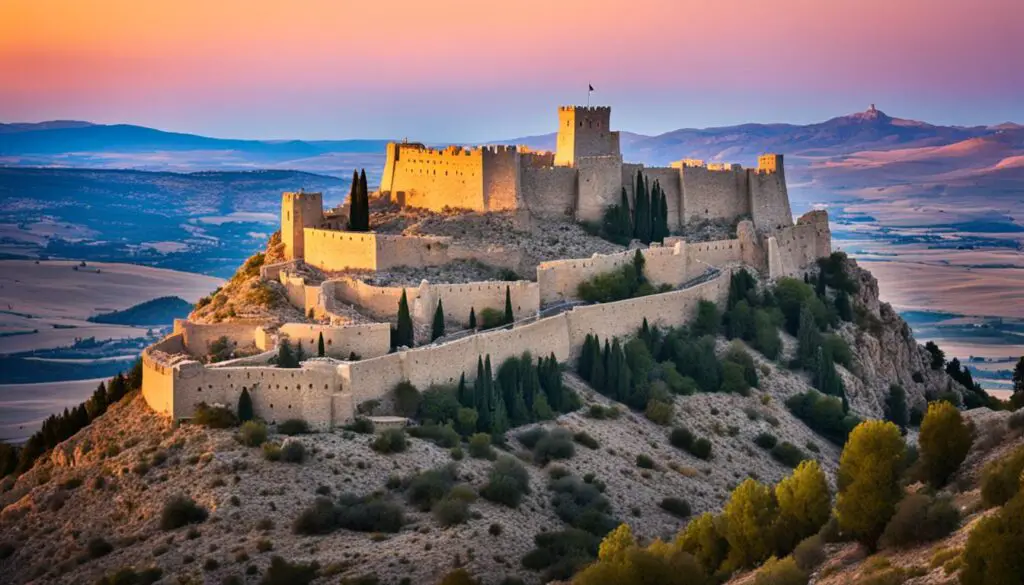
The significance of Machaerus extends beyond its architectural grandeur. According to historical accounts, it is believed to be the site where John the Baptist, a prominent figure in biblical history, was imprisoned and ultimately executed. Herod Antipas, the son of Herod the Great, ordered John the Baptist’s demise in response to a political dilemma.
“But when Herod’s birthday came, the daughter of Herodias danced before the company and pleased Herod, so that he promised with an oath to give her whatever she might ask. Prompted by her mother, she said, ‘Give me the head of John the Baptist here on a platter.’ And the king was sorry, but because of his oaths and his guests he commanded it to be given.”
– Matthew 14:6-9 (ESV)
The fortress of Machaerus endured numerous battles and sieges throughout its existence. It was eventually destroyed by Roman forces, yet the remnants of this ancient structure tell a captivating tale of power, politics, and religious persecution.
Key Facts about Machaerus:
- Machaerus is located in present-day Jordan, approximately 53 kilometers southeast of Amman.
- The fortress was strategically positioned atop a steep hill, providing a vantage point over the surrounding landscape.
- Excavations at Machaerus have revealed various architectural elements, including palaces, courtyards, and cisterns.
- The execution of John the Baptist is a significant event associated with Machaerus, emphasizing its place in biblical history.
- Visitors to Machaerus can explore the ancient ruins, take in breathtaking views of the Dead Sea, and gain a deeper understanding of the region’s historical and religious significance.
Old City of Jerusalem
The Old City of Jerusalem is a UNESCO World Heritage Site that holds immense religious significance for Jews, Christians, and Muslims. It is a place where ancient history and spirituality converge, attracting visitors from around the world.
At the heart of the Old City lies the iconic Temple Mount, a site of great importance to Judaism. According to Jewish tradition, it is here where the first temple, built by King Solomon, once stood. Today, the Western Wall, which was part of the temple’s retaining wall, is a place of prayer and reflection for Jews, symbolizing their connection to the past.
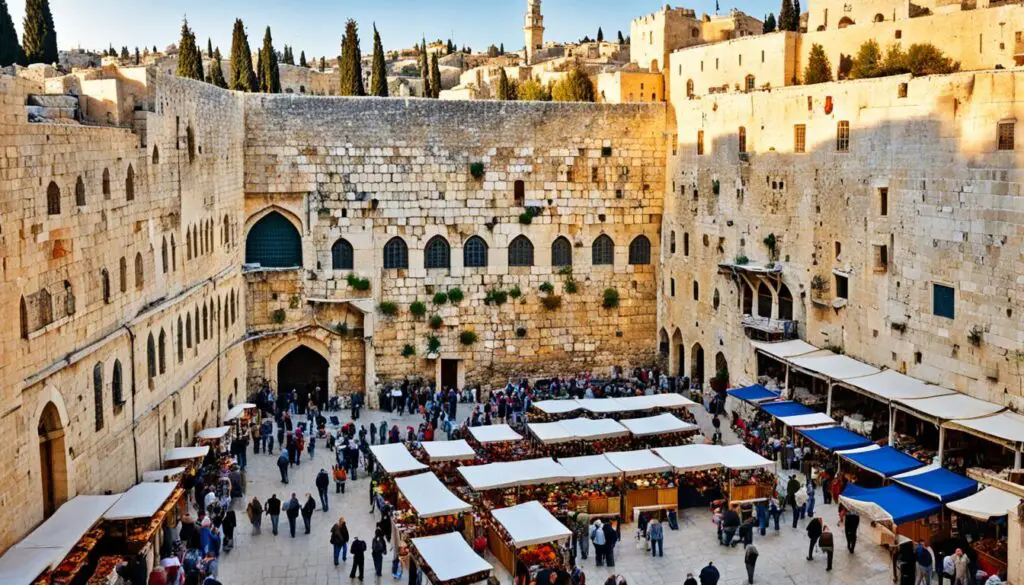
For Muslims, the Temple Mount is home to two significant landmarks – the Dome of the Rock and Al-Aqsa Mosque. The Dome of the Rock, with its stunning golden dome, is believed to be the spot from which the Prophet Muhammad ascended to heaven. It is a symbol of Islam’s rich history and serves as a visual testament to the faith.
The Church of the Holy Sepulchre, located within the Old City, holds deep religious meaning for Christians. It is believed to be the site where Jesus was crucified, buried, and resurrected. Pilgrims from all over the world come to visit this holy place, immersing themselves in the biblical narrative and finding solace in their faith.
Key Religious Landmarks in the Old City of Jerusalem
| Landmark | Religious Significance |
|---|---|
| Dome of the Rock | Believed to be the location where Muhammad ascended to heaven |
| Al-Aqsa Mosque | Considered the third holiest site in Islam |
| Church of the Holy Sepulchre | Site of Jesus’ crucifixion, burial, and resurrection |
| Western Wall | A place of prayer and connection to Jewish heritage |
Exploring the Old City of Jerusalem is a truly immersive experience, walking through its narrow winding streets, and absorbing the diverse cultures and religions that coexist within its walls. The unique blend of history, spirituality, and architectural marvels makes this ancient city a must-visit destination for anyone seeking a deeper understanding of the world’s major religions.
Tel Beersheba
Tel Beersheba, located in the Negev desert of southern Israel, is believed to be the remains of the biblical town of Beersheba. This ancient town holds great historical and religious significance, particularly in connection to the biblical patriarch Abraham.
The Old Testament recounts a story where Abraham, the father of many nations, negotiated with the Philistine king Abimelech over a well at this very site. This interaction highlights the importance of water in the arid desert landscape and sheds light on the daily challenges faced by the inhabitants of Beersheba during that time.
One of the remarkable features of Tel Beersheba is its well-preserved water system, which dates back to the Iron Age. This elaborate network of wells, cisterns, and canals provided a reliable water supply for the settlement. The existence of such a sophisticated water system speaks to the engineering ingenuity of the ancient inhabitants of Beersheba.
“Tel Beersheba offers a fascinating glimpse into the daily lives of the biblical people who dwelled in this ancient town. The water system, in particular, showcases their innovative solutions for surviving in a challenging environment.”
Exploring Tel Beersheba allows visitors to immerse themselves in the history and culture of the biblical era. Walking through the ruins, one can envision the bustling streets, the communal gathering places, and the resilient spirit of the people who called this place home. It is a testament to the endurance and resourcefulness of ancient civilizations.
Archaeological Discoveries at Tel Beersheba
Over the years, archaeological excavations at Tel Beersheba have unearthed various artifacts that provide valuable insights into the lives of the ancient inhabitants. These discoveries include pottery fragments, tools, and jewelry, offering a glimpse into their daily routines, craftsmanship, and trade relationships.
Furthermore, architectural remains discovered at the site indicate the presence of public and private structures, suggesting a thriving community with organized governance and social structures.
The Significance of Tel Beersheba
- Provides insights into the daily life and challenges faced by the biblical people
- Highlights the importance of water in the desert landscape
- Reflects the engineering ingenuity of the ancient inhabitants
- Offers a tangible connection to the biblical narrative and the figure of Abraham
- Contributes to our understanding of ancient civilizations and human history
Visiting Tel Beersheba allows both history enthusiasts and spiritual seekers to delve into the rich tapestry of the biblical world. It offers a unique opportunity to walk in the footsteps of our ancestors and gain a deeper appreciation for the historical and cultural foundations of the modern world.
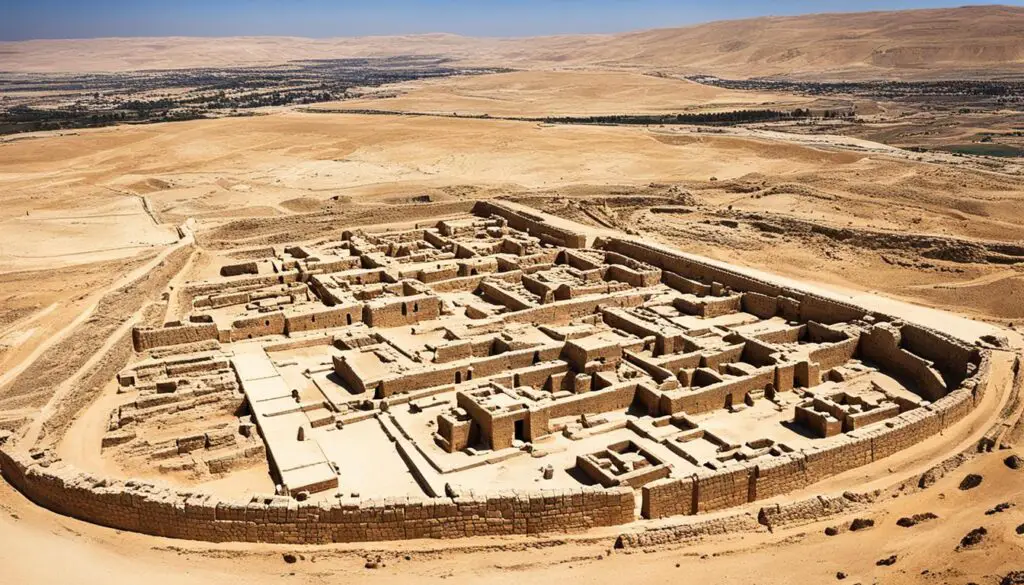
Mount Nebo
Located in Jordan, Mount Nebo is a significant biblical site associated with Moses and holds great historical and religious importance. According to religious texts, Mount Nebo was the mountain from which Moses viewed the Promised Land before he died.
This breathtaking site has been a popular pilgrimage destination since the fourth century. Visitors are drawn to the stunning views of the Holy Land and the Jordan River valley from the summit of Mount Nebo. It offers a unique opportunity to experience the same awe-inspiring vistas that Moses beheld thousands of years ago.
One of the main attractions on Mount Nebo is the Byzantine-era church that stands as a testament to its historical significance. The church is adorned with remarkable mosaics depicting biblical scenes and serves as a place of worship and reflection for visitors from around the world.
“Mount Nebo has a profound spiritual presence and invites visitors to connect with the legacy of Moses and the biblical narrative. Standing at this sacred site, one can’t help but be moved by the immense historical and religious significance it holds.”
Exploring Mount Nebo allows individuals to immerse themselves in the stories and traditions of the Bible, deepening their understanding of the Promised Land and the journey of Moses. The site provides a unique opportunity for personal reflection and contemplation, fostering a deeper connection to faith and history.
Petra
Petra, situated in southern Jordan, is an ancient city carved into red rock cliffs. It was the capital of the Nabatean kingdom and is known for its architectural marvels, including the Treasury and the Monastery.
Petra, also mentioned as “Sela” in the Bible, is a place of great historical and archaeological significance. The Nabateans, an ancient Arab civilization, established a thriving trade hub in Petra, showcasing their advanced engineering skills and artistic flair. The city’s intricate rock-cut facades and elaborate tombs are a testament to the civilization’s prowess and ingenuity.
Archaeological Discoveries
Excavations in Petra have unearthed fascinating artifacts and insights into the city’s past. Archaeologists have discovered ancient irrigation systems, reflecting the Nabateans’ ability to harness water resources in the arid desert environment. They have also found evidence of a sophisticated urban planning system, including aqueducts, cisterns, and paved streets.
“Petra is a remarkable archaeological site that continues to captivate researchers and visitors alike. Each excavation reveals new treasures, shedding light on the daily lives and customs of the Nabateans.”
The ongoing exploration of Petra offers a glimpse into the vibrant civilization that once thrived there, providing invaluable knowledge about ancient trade routes, cultural exchange, and architectural achievements.
Architectural Marvels in Petra
| Name | Description |
|---|---|
| The Treasury | Ancient temple adorned with intricate carvings, serving as the iconic symbol of Petra. |
| The Monastery | A monumental structure with an imposing facade, offering panoramic views of the surrounding landscape. |
| The Great Temple | A large religious complex with several chambers and a massive staircase. |
| The Royal Tombs | An impressive collection of burial sites showcasing the elaborate rock-cut architecture of the Nabateans. |
These architectural marvels showcase the ingenuity and artistic expression of the Nabateans, making Petra a UNESCO World Heritage Site and a must-visit destination for history enthusiasts, explorers, and adventurers.
Conclusion
The historical places mentioned in the Bible hold immense religious and historical significance. They serve as reminders of the events and figures described in biblical texts and provide insights into ancient civilizations and their cultures. These sacred landmarks and historical sites offer a unique opportunity for spiritual and historical exploration, bringing the scriptures to life.
Visiting these biblical sites allows for a deeper connection to one’s faith and an appreciation of the rich history they represent. Whether it’s the ancient city of Megiddo, with its biblical battles and Armageddon significance, or the iconic Old City of Jerusalem, with its religious landmarks such as the Temple Mount and the Western Wall, each site holds its own historical and sacred importance.
From Qumran, where the Dead Sea Scrolls were discovered, to Petra’s breathtaking ancient city, these places offer valuable insights into the stories and teachings of the Bible. Exploring these biblical sites is a remarkable journey that allows individuals to walk in the footsteps of prophets and other central figures, deepening their understanding and connection to their faith.
FAQ
What are some famous biblical sites?
Some famous biblical sites include Tel Megiddo (Armageddon), Qumran (site of the Dead Sea Scrolls), Tel Hazor (site of a significant victory for Joshua), Machaerus (site of John the Baptist’s imprisonment and execution), the Old City of Jerusalem (home to significant religious landmarks), Tel Beersheba (believed to be the biblical town of Beersheba), Mount Nebo (associated with Moses), and Petra (an ancient city mentioned in the Bible).
What is the significance of Tel Megiddo?
Tel Megiddo, also known as Armageddon, is an ancient city in Israel mentioned in the Book of Revelation as the location of the end-times battle. It has 26 layers of human occupation, making it a fascinating site for historical study.
What is the historical importance of Qumran?
Qumran gained fame when the Dead Sea Scrolls were discovered nearby. It is believed to have been an ancient settlement inhabited by the Essenes, a Jewish sect associated with the authorship of the Dead Sea Scrolls.
What is the significance of Tel Hazor?
Tel Hazor is a biblical site in Israel’s Galilee region. It was the site of a significant victory for Joshua during the Israelite conquest of Canaan, as mentioned in the Old Testament. Ongoing excavations provide insights into the biblical battle.
What is the historical significance of Machaerus?
Machaerus is an ancient fortress located in Jordan. It is believed to be the site where John the Baptist was imprisoned and executed on the orders of Herod Antipas. It holds great significance in biblical history.
What religious landmarks can be found in the Old City of Jerusalem?
The Old City of Jerusalem is home to several religious landmarks. It includes the Temple Mount, where the first temple was built according to Jewish tradition. Additionally, it houses the Dome of the Rock, Al-Aqsa Mosque, the Church of the Holy Sepulchre, and the Western Wall.
What is the historical significance of Tel Beersheba?
Tel Beersheba is believed to be the remains of the biblical town of Beersheba. It was the site of Abraham’s negotiation with the Philistine king Abimelech over a well. The well-preserved water system provides insights into the ancient settlement’s infrastructure.
What is the significance of Mount Nebo?
Mount Nebo, located in Jordan, is associated with Moses. It is believed to be the mountain from which Moses viewed the Promised Land before he died. Mount Nebo is a pilgrimage site and features a Byzantine-era church with stunning mosaics depicting biblical scenes.
What is the historical importance of Petra?
Petra, situated in southern Jordan, is an ancient city mentioned as “Sela” in the Bible. It was the capital of the Nabatean kingdom and is known for its architectural marvels, including the Treasury and the Monastery. Ongoing excavations continue to reveal new discoveries.
What is the significance of these biblical sites?
The biblical sites hold immense religious and historical significance. They serve as reminders of the events and figures described in biblical texts and provide insights into ancient civilizations and their cultures. These sacred landmarks and historical sites offer a unique opportunity for spiritual and historical exploration, bringing the scriptures to life.
